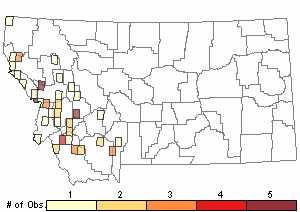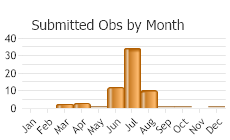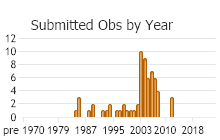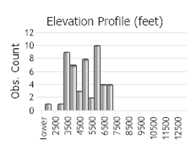View in other NatureServe Network Field Guides
NatureServe
Montana
Utah
Wyoming
Idaho
Wisconsin
British Columbia
South Carolina
Yukon
California
New York
Northern Rocky Mountains Refugium Mayfly - Caudatella edmundsi
State Rank Reason (see State Rank above)
This NRMR mayfly is currently ranked S3 as a "potential species of concern" in Montana because it is potentially at risk of extirpation in the state due to limited and/or declining numbers, range and/or habitat, even though it may be abundant in some areas. This species was taken off the SOC list in 2011 after targeted habitat sampling found many more occurrences and we have determined that they are fairly wide-ranging in the western portion of the state, but still worthy of being watched for future declines.
- Details on Status Ranking and Review
Northern Rocky Mountains Refugium Mayfly (Caudatella edmundsi) Conservation Status Review
Review Date = 09/18/2008
Population Size
ScoreU - Unknown
CommentUnknown.
Range Extent
ScoreD - 1,000-5,000 km squared (about 400-2,000 square miles)
Comment200-1000 km (125-620 miles) linear river
Area of Occupancy
Comment1000-5000 km (620-3000 miles) linear river
Length of Occupancy
ScoreLD - 200-1,000 km (about 125-620 miles)
Long-term Trend
ScoreE - Relatively Stable (±25% change)
CommentSiltation and stream temperature increases with loss of riparian shading (Forestry Practices) and lower snowpack probably contributed to some decline
Short-term Trend
ScoreE - Stable. Population, range, area occupied, and/or number or condition of occurrences unchanged or remaining within ±10% fluctuation
CommentDocumenting many populations since 2006
Threats
ScoreF - Widespread, low-severity threat. Threat is of low severity but affects (or would affect) most or a significant portion of the population or area.
CommentClimate Change, increasing stream temperatures and lower snowpack could seriously impact the habitat that this speces exists in
SeverityLow - Low but nontrivial reduction of species population or reversible degradation or reduction of habitat in area affected, with recovery expected in 10-50 years.
CommentSpecies is probably able to local shift upstream in the watershed to find more suitable habitat should short-term habitat degradation occurs
ScopeModerate - 20-60% of total population or area affected
ImmediacyLow - Threat is likely to be operational within 5-20 years.
CommentThreat is not fully operational now, but some areas have been lost.
Intrinsic Vulnerability
ScoreB - Moderately Vulnerable. Species exhibits moderate age of maturity, frequency of reproduction, and/or fecundity such that populations generally tend to recover from decreases in abundance over a period of several years (on the order of 5-20 years or 2-5 generations); or species has moderate dispersal capability such that extirpated populations generally become reestablished through natural recolonization (unaided by humans).
Environmental Specificity
ScoreC - Moderate. Generalist. Broad-scale or diverse (general) habitat(s) or other abiotic and/or biotic factors are used or required by the species but some key requirements are scarce in the generalized range of the species within the area of interest.
CommentCold water stenotherm, cannot survive increases in water temperatures or will have to migrart to cooler temps
General Description
This yellow-colored Ephemerellid mayfly is a disjunct regional endemic to the Northern Rocky Mountain refugium region centered on the Montana/Idaho border. Other populations are found on the Oregon, Washington and California coastal ranges.
Diagnostic Characteristics
Adult morphology: see Allen (1959) for detailed description. Larval morphology: (See photo) Body length: 6-8 mm, robust thoracic region. Medial caudal filiament much longer than cerci. The dorsal surface of the femora has a fringe of relatively long hairs. Abdominal tergal spines on segments 3-9 are moderately long. Larvae of C. edmundsi could be confused only with larvae of C. hystrix, but the difference in yellowish coloration and the vestigial maxillary palpi of C. edmundsi is significant in differentiation (Jacobus 2006).
Species Range
Montana Range
Range Descriptions

 Native
Native
Range Comments
Rangewide, C. edmundsi is known from the coastal ranges of western Oregon, and California, and more recently from disjunct Idaho and Montana populations. Until a current faunistic study of the west coast and intermountain states is complete, the current global conservation ranking is preliminary.
In Idaho, C. edmundsi as been reported from the Snake River drainage (J. Koebaugh, personal communication), in Myers Creek (Idaho County) within the Nez Pearce National Forest and across the Snake river in Oregon, although specific locations were not mapped.
In Montana, C. edmundsi has been reported from 40 sites on ~20 streams in 7 counties: Beaverhead, Deerlodge, Missoula, Mineral, Granite, Powell and Sanders Counties.
Observations in Montana Natural Heritage Program Database
Number of Observations: 65
(Click on the following maps and charts to see full sized version)
Map Help and Descriptions
Relative Density

Recency



 (Observations spanning multiple months or years are excluded from time charts)
(Observations spanning multiple months or years are excluded from time charts)
Habitat
Very little is known of the habitat preference of this species (P. McCafferty, personal communication, December 2004), but like other Caudatella, this species is associated with relatively pristine, cold flowing streams and rivers (Allen 1961) and is a listed as a coldwater stenotherm (IDDEQ 2002). Hawkins (1984) found C. edmundsi & Drunella spinifera larvae most abundant when associated with mossy cobbles and boulders in an Oregon stream. Most of the Montana collection records are from 2nd-3rd order streams capable of sustaining Westslope cutthroat trout populations with at least 50% riparian shading and mossy cobble/boulder substrate. Sites with this species present, visited in 2006, correlated with this stream type (avg. wetted width-2.5 m, heavy moss growth on the cobbles).
Food Habits
The trophic relationships of Caudatella larvae are scrapers and collectors-gatherers feeding on detritus, algae and diatoms) (Merritt and Cummins 1996).
Management
C. edmundsi has no federal or state agency status at the present time and was not reported to be in Montana. However, as a result of this study, this species is likely to be listed as a USFS SOC, as well as a Montana State Species of Concern by MNHP and MTFWP.
Stewardship Responsibility
Threats or Limiting Factors
All forms of stream quality degradation pose potential threats to cold-water mayflies. These include siltation; pollution from agricultural and industrial waste; and hydrological alteration from diversions, dams, or withdrawal of excess water for human use.
References
- Literature Cited AboveLegend:
 View Online Publication
View Online Publication Hawkins, C.P. 1984. Substrate Associations and Longitudinal Distributions in Species of (Ephemerellidae) (Ephemeroptera:Insecta) from Western Oregon. Freshwater Invertebrate Biology, Vol. 3: No. 4, pp. 181-188
Hawkins, C.P. 1984. Substrate Associations and Longitudinal Distributions in Species of (Ephemerellidae) (Ephemeroptera:Insecta) from Western Oregon. Freshwater Invertebrate Biology, Vol. 3: No. 4, pp. 181-188 Jacobus, L.M., R.L. Newell, and W.P. McCafferty. 2006. First adult and egg descriptions of (Caudatella edmundsi) (Ephemeroptera: Ephemerellidae) from Montana (U.S.A.), with habitat observations. Entomological News, 117(2): 175-180.
Jacobus, L.M., R.L. Newell, and W.P. McCafferty. 2006. First adult and egg descriptions of (Caudatella edmundsi) (Ephemeroptera: Ephemerellidae) from Montana (U.S.A.), with habitat observations. Entomological News, 117(2): 175-180. Merritt, R.W. and K.W. Cummins. 1996. An introduction to the aquatic insects of North America. 3rd Edition. Kendall/Hunt Publishing Company. Dubuque, Iowa. 862 pp.
Merritt, R.W. and K.W. Cummins. 1996. An introduction to the aquatic insects of North America. 3rd Edition. Kendall/Hunt Publishing Company. Dubuque, Iowa. 862 pp.
- Additional ReferencesLegend:
 View Online Publication
View Online Publication
Do you know of a citation we're missing? Allen, R.K. 1959. A new species of Ephemerella from Oregon (Ephemeroptera: Ephemerellidae).Journal of the Kansas Entomological Society 32:59–60.
Allen, R.K. 1959. A new species of Ephemerella from Oregon (Ephemeroptera: Ephemerellidae).Journal of the Kansas Entomological Society 32:59–60. Driear, R. E. 1974. A comparative study of the aquatic insect populations of Rock Creek, Montana and its major tributaries. M.S. thesis. University of Montana.
Driear, R. E. 1974. A comparative study of the aquatic insect populations of Rock Creek, Montana and its major tributaries. M.S. thesis. University of Montana. Garrett, P.A. 1973. The distribution and abundance of aquatic insects in the Middle West Gallatin drainage. M.Sc. Thesis. Bozeman, Montana: Montana State University. 60 p.
Garrett, P.A. 1973. The distribution and abundance of aquatic insects in the Middle West Gallatin drainage. M.Sc. Thesis. Bozeman, Montana: Montana State University. 60 p.
- Web Search Engines for Articles on "Northern Rocky Mountains Refugium Mayfly"
- Additional Sources of Information Related to "Insects"





